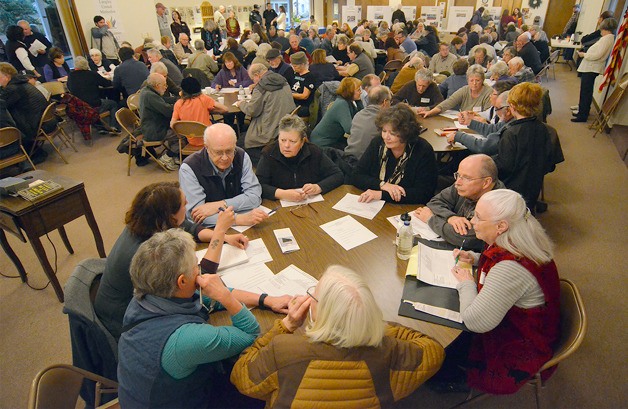Langley got its first sweeping look at projects that could better connect its commercial and residential areas to its waterfront and marina at the long-awaited charrette Tuesday night.
Despite all of the blustery gusto and tension leading up to a public meeting about marina access project options in Langley, the meeting itself was befittingly calm for the Village by the Sea.
More than 100 people packed into Langley United Methodist Church’s fellowship hall, with a capacity of 200, to hear from the director of Community Planning about alternative projects to move people between the city’s commercial core and its waterfront and marina. In a surprise move, planning Director Michael Davolio gave loose cost estimates for most of the projects, which range from $0 to $2 million.
City officials had said previously that it would not address the price tags of various options.
Not surprising to most, the funicular was the lightning rod issue. Based on the applause response of attendees when people spoke in support of a funicular or adding electric golf carts, it was an even split between those two projects.
One of the lingering points of contention was a claim by the city that the bluff is safe for a major project such as a funicular or tram. Several people questioned the assertion that it is stable enough to be built into or upon, noting the slide in March 2013, including funicular critic Sharon Emerson. During the closing question and statement segment, Emerson cited the original project grant application was to use about $250,000 to widen Wharf Street and help stabilize or contain small slide debris.
Similarly, Nell Anders asked the city if it had considered the burden of liability and insurance.
Near the beginning of the city’s presentation of the project options, Davolio acknowledged that some alternatives are less feasible because of the bluff’s slide history and slope.
“There is some challenge with those slopes,” he said.
Davolio listed nine project options the city considered, with a 10th option of not pursuing any of them. Three were eliminated — mini train, escalator and trolley on tracks — because he ruled their construction was not practical.
Another option, a waterfront walkway, was deemed unlikely because of its massive cost and lengthy process. Already in the city’s comprehensive plan, Davolio said it would connect the marina to Seawall Park, but would require Army Corps of Engineers approval among other overwater structure permits and potential eminent domain — the claiming of private property for public benefit, such as a right of way. Davolio said it was estimated to cost as much as $2 million, making it the most expensive possibility and, as he said, still leaving people to hike up either the stairs to Boy and Dog Park or up the hill of Anthes Avenue.
“This is an option that, quite frankly, doesn’t meet all the needs on its own,” he said.
At issue for Langley is its desire to make the trek between the marina and its downtown core easier, provide another way to access Wharf Street and Sunrise Lane, and relieve some of the parking problems presented by the lack of space near the marina. The city’s leaders also view the planned Port of South Whidbey marina expansion as an avenue to increased revenue and economic development.
Some in the crowd supported a project that would build something because beyond moving people, it could be an attraction.
“We as a community essentially have $500,000 of free money,” said Dick McGrath, a Langley resident. “It is something that people would come … just to experience what a funicular is.”
Claims of the funicular’s, or any permanent structure’s, benefits were called into question by several speakers. One man said the city was “putting the chicken before the egg,” and asked Langley officials to provide better estimates and projections of how many people would visit the marina and what that meant for the city’s revenue.
Langley resident Carl Magnusson critiqued the city’s assertions that the project was needed in the first place.
“To what extent is our responsibility to provide grand infrastructure or a transit system?” he asked the crowd.
Ahead for the city’s decision-making process is Davolio’s report to the Planning Advisory Board based on the information gathered from worksheets given to all who attended the charrette. From that information, the planning board will give him input and direction on which alternatives should be researched further before he makes a final recommendation to the board and then the city council.
“None of this is a done deal,” he said.



